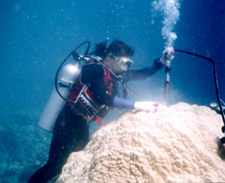| Carbon
Counter
We know that the amount of CO2
going into the atmosphere is increasing. We know that the
physical chemistry of CO2 gas means that the more we pump
into the atmosphere, the warmer it's going to get. ...And
we know that all of this becomes detectable starting around
1850, at the beginning of the Industrial Revolution when
the burning of fossil fuel became more prevalent."
 |
Andréa Grottoli is cataloging
the knowledge base that shores up the "overwhelming consensus
in the scientific community" that global warming is a growing
threat. Grottoli is an assistant professor in the Department
of Earth and Environmental Science and the principal investigator
in the Marine
Biogeochemistry Lab. She knows all this because
her ongoing research is adding to the mounting pile of
evidence that scientists find so convincing. "There is
no other time in the last 400,000 years that we know of,"
she states, "when the rate of increase in CO2 in the atmosphere
has been greater than it has been in the last century."
With
both hands, she lifts a piece of evidence from the drawer
of a laboratory cabinet. It's a chalk-white bar of calcium
carbonate. She drilled it with a hollow bit from a coral
head beneath nine feet of water near the Palau islands
in the Pacific. Corals build up a skeleton of calcium
carbonate, one layer at a time, like the annual growth
rings in a
tree. For researchers like Grottoli who know what to
look for ‚ and have the patience to shave a two-foot coral
core into thousands of slices ‚ the bands of skeletal matter
can yield information on climate going back some 400
years.
"When
I talk about climate," Grottoli explains, "it's
not just air temperature. It's an ocean-atmosphere coupled
system." Earth
is largely an interactive, air-water entity, despite
being named for terra firma. The carbon dioxide dumped
into the
atmosphere makes its way into the chemistry of seawater
and eventually shows up in plants and animals that live
in the worldís oceans. Grottoli looks for those signal
traces in the skeletons of corals and sclerosponges.
Sclerosponges are slow growing filter feeders whose skeletons
also accrete
layers of calcium carbonate. She takes a mushroom-size
specimen from a jar. "Everything marine stinks," she
apologizes. "They
smell like wet dog or low tide." By studying carbon isotopes
in the strata of bone-matter in these creatures, some
of which can grow for centuries, Grottoli can reconstruct
the history of carbon dioxide buildup in the ocean.
In
her most recent work, she looks at the ratios of carbon-13
to carbon-12 in sclerosponges, which are known to parallel
the carbon isotopic composition of seawater. "Fossil
fuel has very little carbon-13, and it has lots of carbon-12,"
she explains. "As we burn more fuel, the carbon dioxide
gets taken up by the ocean. So you have a dynamic exchange
— and an isotopic exchange as well. The ratio of carbon-13
to carbon-12 in the ocean starts to go down, and it turns
out, the ratio of carbon-13 to carbon-12 in sclerosponges
goes down too." Scientists have measured the decrease
in the carbon-isotope ratio in seawater since 1990. Grottoliís
preliminary findings suggest that isotopic analysis of
sclerosponges can extend that data back by another 50
years or more. "It's an evolving science," she
says,
"but the slope dramatically changes as soon as we
start having
the
combustion engine."
Grottoli's research encompasses
a range of other studies, all related to climate change
arising
from the global interaction of oceans, atmosphere and
human activity. "It's the same reason why I think
we should all recycle and why we should all drive fuel-efficient
cars," she
says of her research interests. "It's a sense of
responsibility for the planet and our children and our
future."
-Peter
Nichols
|



